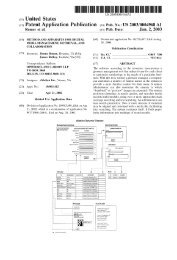Polaroid Corp. v. Eastman Kodak Co. - Oppedahl Patent Law Firm LLC
Polaroid Corp. v. Eastman Kodak Co. - Oppedahl Patent Law Firm LLC
Polaroid Corp. v. Eastman Kodak Co. - Oppedahl Patent Law Firm LLC
Create successful ePaper yourself
Turn your PDF publications into a flip-book with our unique Google optimized e-Paper software.
Intellectual Property Library ISSN 1526-8535<br />
There is expert testimony of Professors Dolan and Buzzel, based upon their surveys of<br />
market conditions, historical sales, and market research. There is expert testimony of<br />
Professors Fisher and Baumol, based on their econometric models.<br />
The second problem is intimately related to the first; it is the question of translating<br />
<strong>Kodak</strong> sales into <strong>Polaroid</strong> sales in the world without <strong>Kodak</strong>, the "but for" world, or to put<br />
it more directly, what price <strong>Polaroid</strong> could have charged for the additional camera sales<br />
in the world without <strong>Kodak</strong>. The only undisputed fact is that quantity and price of the<br />
cameras and film <strong>Kodak</strong> did sell in the infringing years.<br />
Once those questions are resolved, I will turn to marketing and manufacturing capability,<br />
costs, and other issues in the following order: an overview of the historical background<br />
of the case and the parties' positions (Section II); the instant photography market (Section<br />
III); <strong>Polaroid</strong>'s manufacturing capacity (Section IV): costs (Section V); the calculation of<br />
lost profits (Section VI); the calculation of the reasonable royalty rate (Section VII);<br />
willfulness (Section VIII);<br />
Page 1485<br />
attorneys' fees (Section IX); and prejudgment and postjudgment interest (Section X). My<br />
conclusion and a summary of the award appears in Section XI, followed by the<br />
appendices [omitted].<br />
This introduction closes with my acknowledgement that this opinion is lengthy, partly<br />
because my findings and conclusions contain specific references to certain witnesses,<br />
events, or exhibits. Those references should not be construed as the most critical portions<br />
of the record. I considered the entire record, whether produced through trial witnesses,<br />
deposition, exhibits, or stipulations. Not only were witnesses in sharp disagreement, but<br />
thousands of pages of documents, dredged up from long dormant corporate files by<br />
industrious counsel over years of discovery, often contained statements, sometimes by<br />
the witness or by associates, which appeared to belie the position taken at trial. When<br />
confronted with these inconsistencies or discrepancies, witnesses sought to put their own<br />
"spin" on the statements. For example, conflicting views in marketing studies were<br />
sometimes ignored, or dismissed out of hand, or disparaged as "half ideas" or "half<br />
truths," or a "rare sensible comment." Of course, I assessed a witness's credibility, and<br />
weight to be given the testimony, on the usual criteria of fairness, motivation, candor and<br />
demeanor of the witness. In accepting or rejecting positions, I make specific references<br />
to the record when I find the testimony or exhibit particularly compelling or illustrative.<br />
II. AN OVERVIEW<br />
Edwin H. Land, the founder of <strong>Polaroid</strong>, began work on instant photography in 1944. In<br />
December 1948, <strong>Polaroid</strong> introduced the first instant cameras and film. Instant<br />
photography created a sensation, even though it required special handling. In order to<br />
develop the film after taking the picture, the user had to time and pull the print out of the<br />
camera, peel off and dispose of a protective chemical-laden paper backing and apply a<br />
special coating to the final picture. The cameras were heavy and bulky. Over time,<br />
<strong>Polaroid</strong> refined the early system, developing more sophisticated technology, better<br />
design and appearance, better quality photographs and, finally, color prints. 2 Still, even<br />
as late as 1971, the user still had to peel away the protective layer from the finished print.<br />
<strong>Co</strong>pyright 2003, The Bureau of National Affairs, Inc. Reproduction or redistribution, in<br />
whole or in part, and in any form, without express written permission, is prohibited except<br />
as permitted by the BNA <strong>Co</strong>pyright Policy. http://www.bna.com/corp/index.html#V<br />
8





